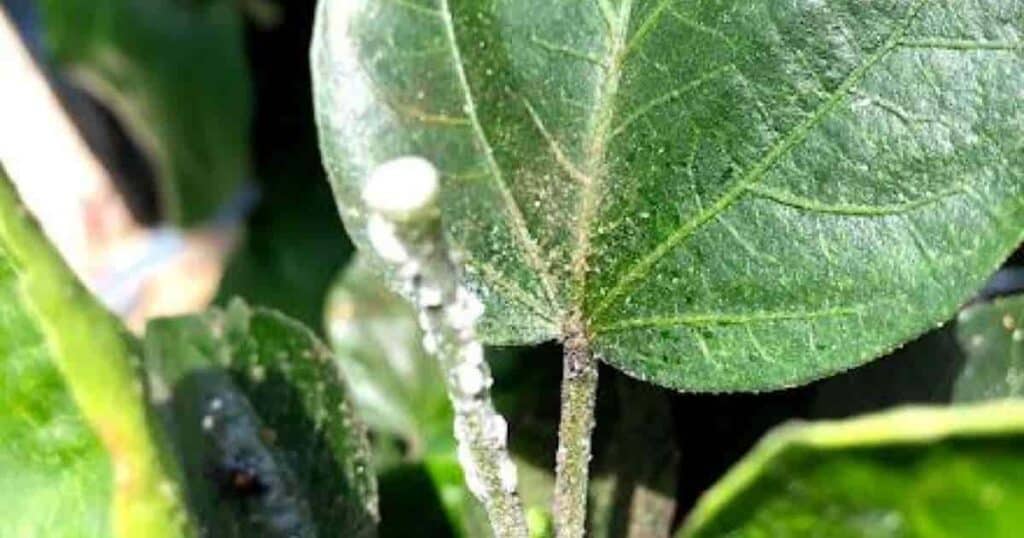Have you ever wondered what mealybugs eat? The quick answer – one of the best natural mealy bug predators is the common ladybug or Lady Bird beetle.
Because they are beetles (Coleoptera), it is more proper to call them Lady Bugs, which is what the Entomological Society of America calls them.

These cheery little red and black insects are members of the group called Hemiptera or “true bugs.”
Other members of the group include:
- Leaf-footed bugs
- Box Elder bugs
- Stink bugs
The most voracious mealybug-eating ladybug is Cryptolaemus montrouzieri, commonly known as the Mealybug Destroyer. These little critters make quick work of all mealybugs but are especially fond of Planococcus citri or citrus mealybugs.
Citrus mealybugs tend to wreak havoc on a wide variety of plants and crops, including:
- Society garlic
- Persimmons
- English Ivy
- Oleander
- Cyclamen
- Gardenia
- Amaryllis
- Begonia
- Hibiscus
- Apples
- Coleus
- Dahlia
- Citrus
These are only a few of the plants.
Mealybug Destroyers are not native to the United States. They were brought in from Australia in 1891 to tackle the citrus mealybug problem in California’s citrus groves.
They quickly naturalized to warmer North American climates and now do well in California, Texas, Florida, and other areas with temperate winters.
- If they do not live in your area naturally, you can purchase them online to release into your garden during the warm months.
- Consider establishing a breeding population of these handy helpers if you have a greenhouse.
They are very beneficial in the control of mealybugs, aphids, and other soft-bodied pest insects.
What Do Mealybug Destroyers Look Like?
Adult Cryptolaemus montrouzieri is two-colored with a reddish-brown head, a black band across the middle, and a reddish-brown tail end.

As the larvae grow older, they become wax-covered. They look somewhat like very large mealybugs, so identify them carefully and correctly to avoid killing off your helpers.
TIP: Keep ants under control because they “farm” mealybugs and other bugs that produce “honeydew” excrement.
How Do You Raise & Release Mealybug Destroyers?
If you have a greenhouse, you can raise the beetles in wide-mouthed jars by allowing some mealybugs to proliferate on plants set aside for that purpose (e.g., potato plants).
You can feed the mealybugs to the ladybug larvae by placing them in the jars.
Put a ring of petroleum jelly around the mouth of the jar so that the mealybugs can’t crawl out.
The Lady Bug larvae can still fly out and populate your greenhouse when they transform into beetles.

You can also release adult beetles in your greenhouse or garden.
You should do this at a time of year when many mealybug egg sacs are present. This will stimulate the Lady Beetles to mate and reproduce.
If you release them with no abundant food source, they will not reproduce.
If releasing adult Lady Bugs into your garden, do so at dusk so that they won’t simply fly off as soon as they are released.
Also, mist your garden before releasing your little helpers. They will be thirsty after being shipped to you, so having a source of water immediately and easily available will also encourage them to stay.
There Are Lots Of Beneficial Insect Helpers
In addition to Lady Bugs, many other beneficial, predatory insects enjoy feasting on mealybugs.
Among them are:
- Larvae of predaceous midges
- Minute pirate bugs
- Brown lacewings
- Green lacewings
- Spiders
Parasitic wasps (parasitoids) are also very good at getting rid of mealybugs from the inside out.
Adults lay their eggs in/on developing mealybugs, and their larvae consume the young mealybugs. As a result, you will see parasitic wasp pupae among mealybug colonies.

You may also see evidence of them in the form of mummified mealybugs pocked with emergence holes.
Helpful parasitic wasps can be found in the genera:
- Pseudaphycus
- Acerophagus
- Coccophagus
- Leptomastix
- Allotrope
You can purchase Leptomastix dactylopii for use in greenhouses, citrus groves, and indoor settings.
However, be advised that this particular wasp is only effective against citrus mealybugs.
How Can You Attract & Keep Beneficial Predatory Insects?
To establish an attractive natural environment for mealy bug predators, plant a butterfly/pollinator garden.
Avoid using broad-spectrum insecticides in your garden.
Look for milder, natural products and apply them carefully and sparingly to keep your natural biological control agents healthy and happy. This way your garden will attract more of what eats mealybugs.
